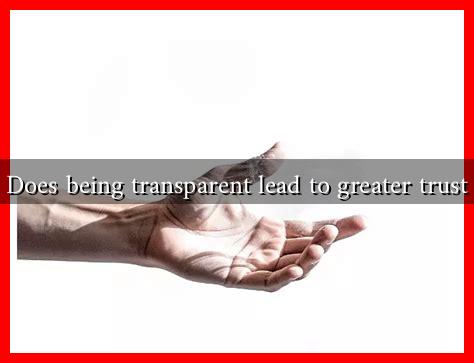-
Table of Contents
Does Being Transparent Lead to Greater Trust?
In an age where information is readily available and skepticism is rampant, the concept of transparency has emerged as a cornerstone of trust-building in various sectors, including business, government, and personal relationships. But does being transparent truly lead to greater trust? This article explores the intricate relationship between transparency and trust, supported by research, case studies, and real-world examples.
The Definition of Transparency
Transparency refers to the practice of openly sharing information, decisions, and processes with stakeholders. It involves clear communication and accountability, allowing individuals and organizations to demonstrate their integrity and reliability. In contrast, opacity can breed suspicion and distrust.
The Psychological Basis of Trust
Trust is fundamentally a psychological construct that develops over time. According to a study published in the journal *Psychological Science*, trust is influenced by several factors, including perceived competence, benevolence, and integrity. Transparency plays a crucial role in enhancing these factors:
- Competence: When organizations share their processes and decision-making criteria, they demonstrate their expertise and capability.
- Benevolence: Open communication about intentions and motivations fosters a sense of goodwill.
- Integrity: Consistent transparency reinforces the belief that an organization adheres to its values and ethical standards.
Case Studies: Transparency in Action
Several organizations have successfully leveraged transparency to build trust with their stakeholders. Here are a few notable examples:
- Buffer: This social media management platform is known for its radical transparency. Buffer openly shares its revenue, salaries, and even the decision-making processes behind its policies. This level of openness has cultivated a loyal customer base and a strong company culture.
- Whole Foods Market: The grocery chain has built trust with consumers by being transparent about its sourcing practices and ingredient lists. By providing detailed information about where their products come from, Whole Foods has established itself as a trustworthy brand in the organic food market.
- Government Transparency Initiatives: Various governments have adopted transparency initiatives to build public trust. For instance, the U.S. government’s Data.gov platform provides access to a wealth of public data, allowing citizens to hold officials accountable and engage in informed discussions.
Statistics Supporting Transparency
Research indicates a strong correlation between transparency and trust. A survey conducted by the Edelman Trust Barometer found that:
- 81% of respondents stated that they need to be able to trust a brand to buy from them.
- 76% of consumers believe that companies should be transparent about their business practices.
- Companies that prioritize transparency are 2.5 times more likely to be trusted by consumers.
These statistics underscore the importance of transparency in fostering trust among consumers and stakeholders.
Challenges of Transparency
While transparency can lead to greater trust, it is not without its challenges. Organizations must navigate the fine line between openness and the potential for information overload or misinterpretation. Some challenges include:
- Information Overload: Providing too much information can overwhelm stakeholders and lead to confusion.
- Misinterpretation: Stakeholders may misinterpret transparent communications, leading to distrust rather than trust.
- Privacy Concerns: Organizations must balance transparency with the need to protect sensitive information.
Conclusion: The Path to Trust Through Transparency
In conclusion, being transparent can significantly enhance trust among stakeholders, as evidenced by numerous case studies and research findings. While challenges exist, the benefits of transparency—such as increased loyalty, improved reputation, and stronger relationships—far outweigh the drawbacks. Organizations that prioritize transparency are likely to foster a culture of trust, leading to long-term success and sustainability.
As we navigate an increasingly complex world, embracing transparency may be one of the most effective strategies for building trust in any relationship, whether personal or professional. For further insights on transparency and trust, you can explore resources from the Edelman Trust Barometer.

